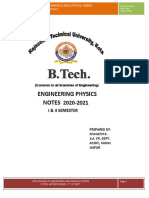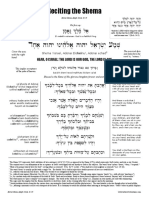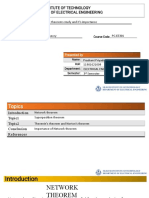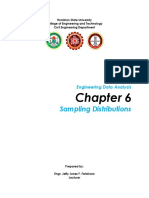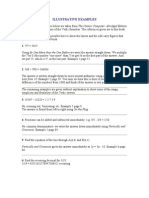Module 6 - Current Divider Rule
Uploaded by
Noel Jr. CornelioModule 6 - Current Divider Rule
Uploaded by
Noel Jr. Cornelio6 Current Divider Rule
Module 6–Current Divider Rule
Learning After finishing this module, you are expected to:
Objectives:
1. Calculate unknown current in a parallel network by
current divider rule.
2. Understand the characteristics of parallel network.
3. Calculate the total resistance, branch current and
power across each resistor in parallel network.
Topics: 1.1. Overview
1.2. Current Divider Rule
1.3. Illustrative Examples
Allotted Time: 2 Hrs.
Introductory Circuit Analysis, 10th Edition, Boylestad
Electrical Circuits Theory and Technology, 3rd Edition, John Bird 2007
Fundamentals of Electric Circuits, Third Edition, Charles A. Alexander & Matthew N.O. Sadiku
Warm Up:
Give three things that you expect you will learn in this module.
1. _________________________________________________________
2. _________________________________________________________
3. _________________________________________________________
_____________
Pre-Test: From the circuit shown calculate the current passing through
the resistors.
Prepared by: Engr. Eddie L. Cabaltera || Camarines Sur Polytechnic Colleges 69
6 Current Divider Rule
1.1. Overview
In the current division rule, it is said that the current in any of the
parallel branches is equal to the ratio of opposite branch resistance to the total
resistance, multiplied by the total current.
In electronics, a current divider is a simple linear circuit that produces
an output current (IX) that is a fraction of its input current. Current division
refers to the splitting of current between the branches of the divider. (Wikipedia)
1.2. Current Divider Rule
The current divider rule (CDR) will determine how the current entering
a set of parallel branches will split between the elements.
For two parallel elements of equal value, the current will divide equally.
For parallel elements with different values, the smaller the resistance,
the greater the share of input current.
For parallel elements of different values, the current will split with a ratio
equal to the inverse of their resistor values.
For networks in which only the resistor values are given along with the
input current, the current divider rule should be applied to determine the
various branch currents. It can be derived using the network of Figure 6.1:
FIGURE 6.1
The input current I equal V/RT, where RT is the total resistance of the
parallel branches. Substituting VN = IN RN into the above equation, where IN
refers to the current through a parallel branch of resistance RN, we have
V I R
I= =
R R
Prepared by: Engr. Eddie L. Cabaltera || Camarines Sur Polytechnic Colleges 70
6 Current Divider Rule
and
R
I = I → eq. (6.1)
R
For Two resistors in parallel as in Figure 6.2
FIGURE 6.2: Applying Current Divider Rule for two resistors in parallel
𝑅 𝑅
𝑅 =
𝑅 +𝑅
𝐼 = 𝐼
𝑅
𝑅
𝐼 = 𝐼 → 𝑒𝑞. (6.2)
𝑅 +𝑅
Similarly, for I2:
𝑅
𝐼 = 𝐼 → 𝑒𝑞. (6.3)
𝑅 +𝑅
In words, for two parallel branches, the current through either branch is
equal to the product of the other parallel resistor and the input current divided
by the sum (not the total parallel resistance) of the two parallel resistances
For Three resistors in parallel:
FIGURE 6.3: Applying Current Divider Rule for three resistors in parallel
Prepared by: Engr. Eddie L. Cabaltera || Camarines Sur Polytechnic Colleges 71
6 Current Divider Rule
𝑅 𝑅 𝑅
𝑅 =
𝑅 𝑅 +𝑅 𝑅 +𝑅 𝑅
𝐼 = 𝐼
𝑅
𝑅 𝑅
𝐼 = 𝐼 → 𝑒𝑞. (6.4)
𝑅 𝑅 +𝑅 𝑅 +𝑅 𝑅
Similarly for I2and I3:
𝑅 𝑅
𝐼 = 𝐼 → 𝑒𝑞. (6.5)
𝑅 𝑅 +𝑅 𝑅 +𝑅 𝑅
𝑅 𝑅
𝐼 = 𝐼 → 𝑒𝑞. (6.6)
𝑅 𝑅 +𝑅 𝑅 +𝑅 𝑅
1.3. Illustrative Examples
EXAMPLE 6.1:
Determine I1 and I2 from Figure 6.4 shown using CDR.
Figure 6.4 for example 6.1
Solution: by CDR.
𝑅 9
𝐼 = 𝐼= (3) = 2.25 𝐴
𝑅 +𝑅 3+9
Prepared by: Engr. Eddie L. Cabaltera || Camarines Sur Polytechnic Colleges 72
6 Current Divider Rule
𝑅 3
𝐼 = 𝐼= (3) = 0.75 𝐴
𝑅 +𝑅 3+9
EXAMPLE 6.2:
From the Figure 6.5 shown below, determine I1, I2 and I3 using CDR.
FIGURE 6.5
Solution: by CDR
𝑅 𝑅
𝐼 = 𝐼
𝑅 𝑅 +𝑅 𝑅 +𝑅 𝑅
(3𝑘)(4𝑘)
= (100𝑚𝐴)
(1𝑘)(3𝑘) + (1𝑘)(4𝑘) + (3𝑘)(4𝑘)
= 63.157 𝑚𝐴
𝑅 𝑅
𝐼 = 𝐼
𝑅 𝑅 +𝑅 𝑅 +𝑅 𝑅
(1𝑘)(4𝑘)
= (100𝑚𝐴)
(1𝑘)(3𝑘) + (1𝑘)(4𝑘) + (3𝑘)(4𝑘)
= 21.052 𝑚𝐴
𝑅 𝑅
𝐼 = 𝐼
𝑅 𝑅 +𝑅 𝑅 +𝑅 𝑅
(1𝑘)(3𝑘)
= (100𝑚𝐴)
(1𝑘)(3𝑘) + (1𝑘)(4𝑘) + (3𝑘)(4𝑘)
= 15.789 𝑚𝐴
https://www.youtube.com/watch?v=VojwBoSHc8U
Watch this video explaining the current divider rule.
Prepared by: Engr. Eddie L. Cabaltera || Camarines Sur Polytechnic Colleges 73
6 Current Divider Rule
Worksheet No. 8
Name: ________________________________Course/Year: ______________
Instructor: _____________________________ Rating: ___________________
PROBLEMS:
Instruction: Solve the following problems and write the solution on the space
provided. Write your final answer on the space provided for.
1. From the circuit shown in Figure 6.5, determine the curentI1, I2, and I3 using
Current Divider Rule (CDR)
FIGURE 6.6 of problem 1
Prepared by: Engr. Eddie L. Cabaltera || Camarines Sur Polytechnic Colleges 74
6 Current Divider Rule
2. From the circuit shown in Figure 6.7, determine the current I1, I2, and I3 using
Current Divider Rule (CDR)
FIGURE 6.7 of problem 2
Prepared by: Engr. Eddie L. Cabaltera || Camarines Sur Polytechnic Colleges 75
6 Current Divider Rule
3. From the circuit shown in Figure 6.8, determine the value of R and current I1,
I2, and I3 using Current Divider Rule (CDR)
FIGURE 6.8 of problem 3
Prepared by: Engr. Eddie L. Cabaltera || Camarines Sur Polytechnic Colleges 76
6 Current Divider Rule
4. From the circuit shown in Figure 6.9, determine the current and the value of R
using Current Divider Rule.
FIGURE 6.9 of problem 4
Prepared by: Engr. Eddie L. Cabaltera || Camarines Sur Polytechnic Colleges 77
6 Current Divider Rule
5. From the circuit shown in Figure 6.9, determine the currentI2, I3, I4and IT using
Current Divider Rule (CDR)
FIGURE 6.9 of problem 5
Prepared by: Engr. Eddie L. Cabaltera || Camarines Sur Polytechnic Colleges 78
You might also like
- PhET Simulation of DC & AC Circuit ExperimentNo ratings yetPhET Simulation of DC & AC Circuit Experiment10 pages
- Experiment 6 - Ohms Law - Using PhET SimulationNo ratings yetExperiment 6 - Ohms Law - Using PhET Simulation3 pages
- Introduction To Electromagnetism: Vector AnalysisNo ratings yetIntroduction To Electromagnetism: Vector Analysis9 pages
- Taifa Secondary School Physics 1 Exam 2019 PDFNo ratings yetTaifa Secondary School Physics 1 Exam 2019 PDF4 pages
- Engineering Dynamics - Chapter 1 & 2 FinalNo ratings yetEngineering Dynamics - Chapter 1 & 2 Final65 pages
- Worksheet#9.2 - Ampere's Law Solutions - 2No ratings yetWorksheet#9.2 - Ampere's Law Solutions - 25 pages
- Work Energy and Power (Including Notes of Power)No ratings yetWork Energy and Power (Including Notes of Power)15 pages
- Engineering Mechanics Dynamics: Kinematics of ParticlesNo ratings yetEngineering Mechanics Dynamics: Kinematics of Particles53 pages
- Electrical Principles (EET0113) : Direct Current (DC)No ratings yetElectrical Principles (EET0113) : Direct Current (DC)10 pages
- Chapter 15 - Oscillations - Solutions PDFNo ratings yetChapter 15 - Oscillations - Solutions PDF9 pages
- Crystallographic Planes and Directions: Author: Nicola ErgoNo ratings yetCrystallographic Planes and Directions: Author: Nicola Ergo28 pages
- Electricity & Magnetism Lecture 1: Coulomb's LawNo ratings yetElectricity & Magnetism Lecture 1: Coulomb's Law16 pages
- Magnetic Field Due To Current Carrying Conductor (MCQ) - Electrical Study ANo ratings yetMagnetic Field Due To Current Carrying Conductor (MCQ) - Electrical Study A10 pages
- Network Theorems Study and It's ImportanceNo ratings yetNetwork Theorems Study and It's Importance7 pages
- Sample Problems in Series and Parallel CircuitsNo ratings yetSample Problems in Series and Parallel Circuits11 pages
- Final PPT On Load Forecasting by Roll 1112 & 1137No ratings yetFinal PPT On Load Forecasting by Roll 1112 & 113716 pages
- Sampling Distributions: Engineering Data AnalysisNo ratings yetSampling Distributions: Engineering Data Analysis14 pages
- 3.1 Conceptual Questions: Chapter 3 Kinematics in Two or Three Dimensions VectorsNo ratings yet3.1 Conceptual Questions: Chapter 3 Kinematics in Two or Three Dimensions Vectors18 pages
- (ECE 401) Lecture 2 Vector Analysis - Part 2No ratings yet(ECE 401) Lecture 2 Vector Analysis - Part 226 pages
- Reviewer Electrical Circuits 1 Eea Exam 2No ratings yetReviewer Electrical Circuits 1 Eea Exam 217 pages
- Qureshi Et Al. 2014 An Empirical Relationship Between In-Situ Permeability and RQD of Discontinuous Sedimentary Rocks PDFNo ratings yetQureshi Et Al. 2014 An Empirical Relationship Between In-Situ Permeability and RQD of Discontinuous Sedimentary Rocks PDF10 pages
- Stephanie Paladino (Editor), Shirley J Fiske (Editor) - The Carbon Fix - Forest Carbon, Social Justice, and Environmental Governance-Routledge (2016)No ratings yetStephanie Paladino (Editor), Shirley J Fiske (Editor) - The Carbon Fix - Forest Carbon, Social Justice, and Environmental Governance-Routledge (2016)356 pages
- Gadgets For Management of Stored Products InsectsNo ratings yetGadgets For Management of Stored Products Insects48 pages
- Illustrative Examples of Vedic MathematicsNo ratings yetIllustrative Examples of Vedic Mathematics3 pages
- Instant download (Ebook) Antennas for All Applications by John D. Kraus, Ronald J. Marhefka ISBN 9780072321036, 9780071122405, 0072321032, 0071122400 pdf all chapter100% (4)Instant download (Ebook) Antennas for All Applications by John D. Kraus, Ronald J. Marhefka ISBN 9780072321036, 9780071122405, 0072321032, 0071122400 pdf all chapter86 pages
- Part F - DUCV - Stage 14 - Mechanical Services Drawings - TenderNo ratings yetPart F - DUCV - Stage 14 - Mechanical Services Drawings - Tender5 pages
- RecoverPoint WARNING RPA fan failure detected. Contact EMC Customer Service. Dell 中国No ratings yetRecoverPoint WARNING RPA fan failure detected. Contact EMC Customer Service. Dell 中国3 pages
- MDCT: Technical Principles and Future Trends: Mathias ProkopNo ratings yetMDCT: Technical Principles and Future Trends: Mathias Prokop8 pages
- Area and Volume Formula For Geometrical FiguresNo ratings yetArea and Volume Formula For Geometrical Figures1 page
- AC 14002 Flight Dispatcher Training and Approval20200814 FinalNo ratings yetAC 14002 Flight Dispatcher Training and Approval20200814 Final32 pages
- CLT South Africa Xlam Brochure-Version-2.0No ratings yetCLT South Africa Xlam Brochure-Version-2.010 pages
- Pole Shift Ning: Antarctic Plate LiftingNo ratings yetPole Shift Ning: Antarctic Plate Lifting7 pages
- D88 - 07 Standard Test Method For Saybolt ViscosityNo ratings yetD88 - 07 Standard Test Method For Saybolt Viscosity7 pages
- Grade 8 Study List Term 3 Final Exam ZehranNo ratings yetGrade 8 Study List Term 3 Final Exam Zehran11 pages
- Engineering Mechanics Dynamics: Kinematics of ParticlesEngineering Mechanics Dynamics: Kinematics of Particles
- Electrical Principles (EET0113) : Direct Current (DC)Electrical Principles (EET0113) : Direct Current (DC)
- Crystallographic Planes and Directions: Author: Nicola ErgoCrystallographic Planes and Directions: Author: Nicola Ergo
- Magnetic Field Due To Current Carrying Conductor (MCQ) - Electrical Study AMagnetic Field Due To Current Carrying Conductor (MCQ) - Electrical Study A
- 3.1 Conceptual Questions: Chapter 3 Kinematics in Two or Three Dimensions Vectors3.1 Conceptual Questions: Chapter 3 Kinematics in Two or Three Dimensions Vectors
- Qureshi Et Al. 2014 An Empirical Relationship Between In-Situ Permeability and RQD of Discontinuous Sedimentary Rocks PDFQureshi Et Al. 2014 An Empirical Relationship Between In-Situ Permeability and RQD of Discontinuous Sedimentary Rocks PDF
- Stephanie Paladino (Editor), Shirley J Fiske (Editor) - The Carbon Fix - Forest Carbon, Social Justice, and Environmental Governance-Routledge (2016)Stephanie Paladino (Editor), Shirley J Fiske (Editor) - The Carbon Fix - Forest Carbon, Social Justice, and Environmental Governance-Routledge (2016)
- Instant download (Ebook) Antennas for All Applications by John D. Kraus, Ronald J. Marhefka ISBN 9780072321036, 9780071122405, 0072321032, 0071122400 pdf all chapterInstant download (Ebook) Antennas for All Applications by John D. Kraus, Ronald J. Marhefka ISBN 9780072321036, 9780071122405, 0072321032, 0071122400 pdf all chapter
- Part F - DUCV - Stage 14 - Mechanical Services Drawings - TenderPart F - DUCV - Stage 14 - Mechanical Services Drawings - Tender
- RecoverPoint WARNING RPA fan failure detected. Contact EMC Customer Service. Dell 中国RecoverPoint WARNING RPA fan failure detected. Contact EMC Customer Service. Dell 中国
- MDCT: Technical Principles and Future Trends: Mathias ProkopMDCT: Technical Principles and Future Trends: Mathias Prokop
- AC 14002 Flight Dispatcher Training and Approval20200814 FinalAC 14002 Flight Dispatcher Training and Approval20200814 Final
- D88 - 07 Standard Test Method For Saybolt ViscosityD88 - 07 Standard Test Method For Saybolt Viscosity


